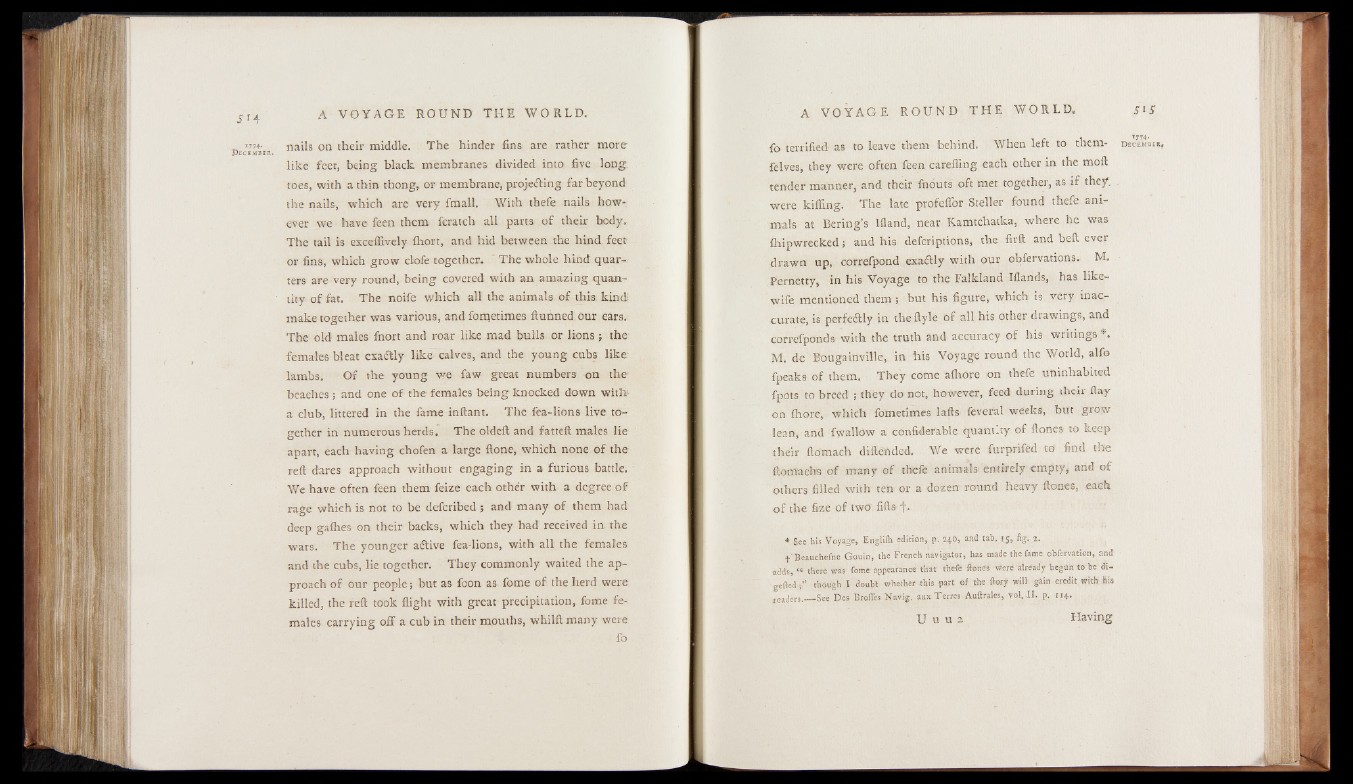
S 14
_ *” +• nails on their middle. The hinder DECEMBER. fins are rather more
like feet, being black membranes divided into five long,
toes, with a thin thong, or membrane, projecting far beyond
the nails, which are very fmall. With thefe nails however
we have feen them fcratch all parts of their hody.
The tail is cxceffively fhort, and hid between the hind feet
or fins, which grow clofe together. ~ The whole hind quarters
are very round, being covered with an amazing quantity
of fat. The noife which all the animals, of this kind
make together was various, and fometimes Itunned our ears.
The old males fnort and roar like mad bulls or lions ; the
females bleat exadtly like calves, and the young cubs like
lambs. Of the young we faw great numbers on the
beaches ; and one of the females being knocked down with
a club, littered in the fame inftant. The fea-lions live together
in numerous herds. The oldeft and fatteft males lie
apart, each having chofen a large ftone, which none of the
reft dares approach without engaging in a furious battle.
We have often feen them feize each other with a degree of
rage which is not to be defcribed ; and many of them had
deep gafties on their backs, which they had received in the
wars. The younger a&ive fea-lions, with all the females
and the cubs, lie together. They commonly waited the approach
of our people; but as foon as fome of the herd were
killed, the reft took flight with great precipitation, fome females
carrying off a cub in their mouths, whilft many were
fo
fo terrified as to leave them behind. When left to them-
felves, they were often feen careffing each other in the moft
render manner, and their fnóuts oft met together, as if they,
were killing. The late profeffor Steller found thefe animals
at Bering’s lfland, near Kamtchatka, where he was
fhipwrecked; and his defcriptions, the firft and beft ever
drawn up, correfpond exactly with our obfervations. M.
Pernetty, in his Voyage to the Falkland Iflands, has like-
wife mentioned them; but his figure, which is. very inaccurate,
is perfedtly in the ftyle of all his other drawings, and
correfponds with the truth and accuracy of his writings*.
M. de Bougainville, in his Voyage round the World, alfo
fpeaks of them. They come aftiore on thefe uninhabited
fpots to breed ; they do not, however, feed during their flay
on fhore, which fometimes Iafts fever'al weeks, but grow
lean, and fwallow a confiderable quantity of ftones to keep
their ftomach diftended. We were furprifed to find the
ftomachs of many of thefe animals' entirely empty, and of
others filled with ten or a dozen round heavy ftones, each
o f the fize of two fills f .
* See his Voyage, Englifli edition, p. 240, and tab, 15, fig. 2.
t'Beauchefne Gouin, thé French navigator, has made the fame obfervation, and
odds, “ there was fome appearance that thefe ftones were already begun to be digged
i” though I doubt whether this part of the ftory will gain credit with his
readers.__See Des Brofles Navig. auxTerres Auftrales, vol, II. p. 114.
U u u 2 Having
1774.
D ec em b e r ,